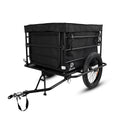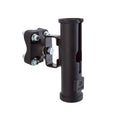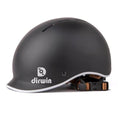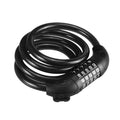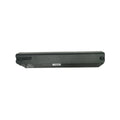Pedal Into Safety With Beginner E-Biking Essentials
 |

|

|

|

|
Pedal Into Safety With Beginner E-Biking Essentials

As electric biking gains popularity for fitness and eco-friendly transportation, many beginners are eager to start but unsure where to begin.
This guide provides essential information on safety gear, bike selection, and road navigation to help new cyclists ride with confidence.
From choosing the right helmet to understanding basic traffic rules, we'll cover key aspects to ensure a safe and enjoyable cycling experience. Let's get you ready to roll!
Necessary Safety Gear Before Starting to Cycle
When cycling as a beginner, equipping oneself with the appropriate safety gear is paramount to ensuring a secure and enjoyable experience. The best safety gear for protection, visibility, and comfort include:
Helmet |
The helmet is the most important piece of safety equipment for cyclists. Statistics from the National Safety Council reveal that in 2022, there were 1,360 fatalities among cyclists. Wearing a helmet greatly reduces the risk of injury or death. |
The pie chart below shows the percentage of U.S. bicyclist fatalities in 2015 influenced by helmet use, according to the National Safety Council.

The pie chart illustrates U.S. bicyclist fatalities by helmet use in 2015. About 54% of deaths involved cyclists who were not wearing helmets, showing the high risks of riding unprotected.
Meanwhile, 29% of fatalities occurred among cyclists wearing helmets, suggesting that helmets reduce the likelihood of fatal injuries.
The yellow segment represents 17% of cases in which it was unknown whether the cyclist was wearing a helmet. Overall, the chart emphasizes the key role helmets play in reducing the risk of fatal head injuries for cyclists.
Additionally, the American Academy of Pediatrics reports that helmets reduce the chance of head injury by 85%, brain injury by 88%, and severe brain injury by 75%. For maximum protection, cyclists should ensure their helmet fits snugly, has proper ventilation, and is secured with a well-fastened chin strap.
Reflective Clothing and Accessories |
Visibility is crucial for cyclists, particularly in low-light conditions. Reflective clothing, such as jackets or vests, enhances a cyclist’s visibility to motorists. Wearing high-visibility apparel can decrease cyclists' risk of vehicle collisions by over 50%. |
Gloves |
Biking gloves can minimize minor hand injuries, offer warmth in chilly weather, and provide padding to avoid nerve compression. Cycling gloves also improve grip, reduce hand fatigue and provide protection during a fall. |
Protective Eyewear |
Cycling eyewear offers multiple benefits. Quality protective units provide essential safeguards against UV rays, wind, dust, and debris while ensuring optimal light transmission control for cyclists. |
Choosing the Right Helmet
Selecting the appropriate helmet is key to cycling safety, as it reduces the risk of head injuries. Things to consider before choosing a helmet include:
Compliance Standards
When choosing a helmet, the first consideration should be compliance with safety standards. In the United States, helmets should meet the Consumer Product Safety Commission (CPSC) standards.
You can also choose helmets that meet the safety standards set by the American Society for Testing and Materials (ASTM) and the American National Standards Institute (ANSI).
Proper Fit
A properly fitting helmet should sit level on the head, covering the forehead without tilting backward or forward. It should be snug but not uncomfortably tight.
Measure the circumference of the head approximately one inch above the eyebrows and select a helmet size that corresponds to this measurement to ensure a correct fit. Most helmets have adjustable straps and a retention system to fine-tune the fit.
Good Ventilation
Helmet ventilation is important, particularly for those cycling in warm climates or engaging in high-intensity rides. Helmets with multiple vents allow for airflow, helping to regulate temperature and reduce perspiration.
Light Weight
A lighter helmet can enhance comfort, especially on long rides. Advanced materials such as in-mold polycarbonate shells and expanded polystyrene foam are commonly used to balance weight and protection.
Safety Features
Including rotation damping systems and collapsible cellular structures, it outperforms conventional helmets in reducing kinematic-based head injuries during cycling at low impact speeds and angular momentum.
Choosing the Right Type of E-Bike for Beginners

When selecting an e-bike as a beginner, it is important to consider the type of cycling you intend to pursue, as this will influence the choice of bicycle. The primary categories of e-bikes based on design and purpose include:
Fat Tire E-bikes
These e-bikes have wide, fat tires designed for all-terrain use. They offer superior traction and stability on uneven surfaces like sand, snow, or rocky paths. Their rugged build makes them perfect for outdoor adventurers.
Commuter E-bikes
Electric commuter bikes are designed for urban environments and offer a smooth, energy-efficient way to navigate city streets. Lightweight and fast, they feature ergonomic designs and reliable motors, making daily commutes easier and more environmentally friendly.
Cargo Electric Bikes
These e-bikes are built to carry heavy loads or additional passengers conveniently. They feature powerful motors and sturdy frames, which are ideal for families or businesses that need to transport goods across short or medium distances without relying on a car.
Folding Electric Bikes
Folding electric bikes combine convenience with portability, perfect for commuters or those with limited storage. They are easy to carry and compact when folded, making them an excellent option for city living, public transport, or tight spaces.
Ensuring Safety During Cycling
The graph highlights a troubling upward trend in the fatalities of bicyclists on U.S. roads from 2011 to 2015.

The upward slope in cyclist fatalities is a reminder of the importance of comprehensive safety measures, especially for new cyclists. This trend emphasizes the need for beginners to approach cycling with caution and preparedness.
Additionally, a study by the U.S. Department of Transportation highlights that between the years 2015 and 2019, intersections accounted for around 57 percent of bicyclist fatalities and 39 percent of pedestrian deaths, as well as incapacitating injuries, in the U.S.
Given these alarming statistics, it's clear that following basic safety guidelines is important for all cyclists. The following guidelines are essential to enhance safety and reduce the likelihood of accidents while cycling on the roads:
Obey Traffic Signals and Signs
Cyclists are required to follow the same traffic signals and signs as motor vehicles. This includes stopping at red lights and stop signs, yielding to pedestrians, and adhering to road markings. Compliance with these rules is not only a legal obligation but also a key component of road safety.
Ride in the Direction of Traffic
Bike riders should ride in the direction of traffic flow and maintain a safe distance from the curb to avoid potential hazards. Riding against traffic increases the likelihood of collisions, as drivers may not expect or see cyclists coming from the opposite direction.
Maintain a Safe Distance
Cyclists must maintain a safe distance from parked cars to avoid being hit by suddenly opened doors, a phenomenon known as “dooring.” A minimum distance of three feet is recommended to provide adequate reaction time and space.
Be Aware of Blind Spots
Cyclists should recognize the blind spots of larger vehicles, such as trucks and buses. These vehicles have limited visibility, and cyclists should avoid lingering in these areas to prevent accidents. It is advisable to position oneself where the driver can see the cyclist in their mirrors.
Use Designated Bike Lanes
Where available, cyclists should utilize designated bike lanes. These lanes are specifically designed to provide a safer environment for cyclists by separating them from motor vehicle traffic. The Federal Highway Administration reports that bike lanes can reduce cycling accidents by up to 53%.
Stay Alert and Avoid Distractions
Cyclists must remain vigilant and focused on their surroundings. This includes avoiding using mobile phones or headphones that can distract from the road and impair the ability to hear approaching vehicles or emergency signals.
Adhere to Speed Limits
According to the World Health Organization, cyclists should prioritize using roads where motorized traffic speeds are controlled to a maximum of 18 miles per hour (MPH), as lower speed limits have been shown to reduce the risk of cyclist fatalities and injuries.
Motor vehicle speeds of 18MPH or lower create safer environments for cyclists by minimizing stopping distances and reducing the severity of potential collisions.
Actions to Take in Case of an Emergency During Cycling
Cycling offers freedom and adventure, but it also comes with the responsibility of staying prepared for unexpected emergencies. Here are essential steps for handling emergencies to make your cycling experience enjoyable and secure:
Essential Items for Emergencies
Cyclists should carry essential items that can assist in various emergencies. These items include a basic first aid kit, a multi-tool for e-bike repairs, a spare inner tube, tire levers, a mini pump, and a mobile phone for communication and navigation purposes.
Dealing with Mechanical Issues
When faced with a mechanical issue such as a flat tire, cyclists should first move to a safe location away from traffic. The cyclist can remove the wheel and replace the inner tube by utilizing the multi-tool and tire levers. Practicing these repairs in a controlled environment is advisable to ensure proficiency during an emergency.
Handling Accidents
In the unfortunate event of an accident, the cyclist should assess their physical condition and seek medical attention if necessary. Approximately 938 cyclists were killed in traffic crashes in the United States in 2020, highlighting the importance of immediate medical evaluation.
If the cyclist is able, they should document the scene by taking photographs and gathering contact information from any witnesses. This documentation can be vital for insurance claims and legal proceedings.
Addressing Personal Safety Concerns
For personal safety concerns, such as feeling threatened by an individual or group, cyclists should remain calm and attempt to reach a populated or well-lit area.
Utilizing a mobile phone to contact local authorities can provide an additional layer of security. Before embarking on a ride, informing a trusted contact of the cycling route and estimated return time is also beneficial.
Adverse Weather Conditions
Cyclists should be aware of the potential for adverse weather conditions, which can rapidly escalate into emergencies. Checking weather forecasts before departure and carrying appropriate gear, such as a waterproof jacket, can mitigate risks associated with sudden weather changes.
Essential Tools for Basic E-Bike Maintenance
A well-maintained e-bike is less likely to experience mechanical failures, which can reduce the risk of accidents.
Each bicycle component requires specific tools and attention to maintain performance and prevent costly repairs.
The table below provides a breakdown of essential bike components, the tools required for maintenance, their purposes, and some commonly associated issues.
| Component | Tool/Tools Required | Purpose | Common Issue |
| Tires | Bike Pump, Tire Levers | Maintain pressure, remove tire | Low-pressure, flats |
| Chain/Drivetrain | Chain Lubricant, Cleaning Supplies | Reduce wear and tear | Rust, friction buildup |
| Wheels | Spoke Wrench | Adjust spoke tension, true wheels | Wobble |
| Bolts | Multi-tool (hex keys) | Tighten bolts on stem, seat post, etc. | Loose bolts |
Examples of How Safety Gear Prevents Cycling Injuries
Understanding the importance of safety measures for cyclists is important for accident prevention. Wearing helmets and adopting proper riding habits reduces injury risks and improves cyclist safety. Here are two case studies that illustrate the impact of these safety measures:
Broad Review of Cycling Accident Data
A 2023 study titled "Effectiveness of Bicycle Helmets and Injury Prevention" by Carlson Moses Büth, Natalia Barbour, and Mohamed Abdel-Aty, published in Scientific Reports, comprehensively examined the benefits of wearing helmets while cycling.
The researchers extensively reviewed meta-analyses on bicycle crash data, incorporating diverse methodologies ranging from observational studies to laboratory simulations. This broad approach allowed them to cover various factors contributing to injury severity and prevention in cycling accidents.
The study consistently confirmed the protective advantages of helmet use, regardless of the cyclist's age, the severity of the crash, or the type of accident. Helmets proved particularly effective in high-risk situations, such as cycling on shared roads, where they reduced severe head injuries.
The study reinforces the crucial role of helmet use in ensuring safety on the road, an essential takeaway for novice cyclists starting their journey.
Improving Rider Safety Through Education and Gear Awareness
A case study, "Risk Riding Behaviors of Urban E-Bikes” analyzed how risky riding behaviors, such as red-light running, lane encroachment, and speeding, contribute to rising accidents among e-bike users.
To address these risks, various safety interventions were implemented, such as enforcing traffic rules for e-bikes. Efforts were also made to incorporate structured training programs, educating new riders about proper riding techniques, rules of the road, and the importance of wearing appropriate gear.
The study's results were promising. After educating new cyclists about proper riding techniques and rules of the road, there was improved traffic flow and minimal collision between cyclists and other road users.
Ultimately, this case study highlights that educating new cyclists about the risks of speeding, illegal lane use, and red-light running helps prevent e-bike crashes.
Essential Practices for New Cyclists

Improving cycling skills as a beginner involves a multifaceted approach encompassing physical conditioning, technical proficiency, and strategic planning. Each of these components plays a key role in enhancing overall cycling performance and safety.
Physical Conditioning
Cycling is an aerobic activity that requires sustained cardiovascular effort. Beginners should gradually increase their ride duration and intensity.
Strength Training
Incorporating strength training exercises, such as squats and lunges, can improve muscle endurance and power output. Cyclists who engage in regular strength training experience increased cycling efficiency.
Flexibility and Core Stability
Flexibility exercises, such as yoga or dynamic stretching, engaging in stretching exercises can enhance the cyclist's flexibility, subsequently increasing their joint mobility, which can improve their cycling performance.
Core stability exercises, including planks and bridges, are essential for maintaining proper posture and balance on the bike.
Bike Handling Skills
Mastering basic bike handling skills, such as braking, cornering, and gear shifting, is crucial. Practicing these skills in a controlled environment, such as an empty parking lot, can build balance, control and confidence.
Pedaling Technique
Efficient pedaling involves a smooth, circular motion rather than a choppy, up-and-down action. Clipless pedals can facilitate this technique by allowing a more even force distribution throughout the pedal stroke.
Use hand Signals
Proper communication with other road users is essential. Cyclists should use hand signals to indicate turns and stops. This practice helps inform drivers and pedestrians of a cyclist’s intentions, reducing the potential for misunderstandings and collisions.
Progress Tracking
Utilizing technology, such as cycling apps or GPS devices, can help track progress and identify areas for improvement. Data analysis can reveal trends in performance and inform future training decisions.
Structured Training Programs
Following a structured training program can optimize skill development and performance gains. Programs should be tailored to individual fitness levels and gradually increase in complexity and intensity.
Common Mistakes to Avoid When Starting Out
When embarking on a cycling journey, beginners often encounter several common pitfalls that can hinder their progress and enjoyment. Recognizing and avoiding these mistakes can enhance the cycling experience and promote safety and efficiency.
Proper Bike Fit |
A poorly fitted e-bike can lead to discomfort, inefficient pedaling, and injury. Improper bike fit is a leading cause of cycling-related musculoskeletal issues, with cyclists experiencing discomfort due to incorrect adjustments. Ensuring that the saddle height, handlebar position, and frame size are appropriately adjusted to the rider’s body dimensions is essential. |
Brian Bradley, a physiotherapist at UW Health's Sports Rehabilitation, emphasizes that:
“Many people assume that pain while riding is normal. You may start shaking out your hands after just 20 minutes because they’re numb. That’s not a normal part of riding. It means you might not fit well on your bike, and adjustments may be needed.”
Overexertion |
New cyclists may be tempted to push their limits too quickly, leading to fatigue and an increased risk of injury. It is essential to gradually build endurance and strength, adhering to a structured training plan for adequate rest and recovery. |
Improper Cycling Posture |
Maintaining a neutral spine position, with relaxed shoulders and a slight bend in the elbows, can prevent strain on the neck and back. |
Inadequate Hydration and Nutrition |
Cycling requires adequate fuel and liquid consumption to uphold performance levels and avert dehydration as an endurance activity. |
Planning Effective Cycling Routes
When selecting a cycling route, several factors must be considered to ensure safety, enjoyment, and alignment with personal fitness levels. The following elements are essential in the decision-making process:
Considering Daylight Riding Risks
Understanding when and how to ride safely can enhance your cycling experience. The majority of bicyclist fatalities occur during daylight hours, with over half taking place between noon and 6 p.m.
The graph below challenges the common assumption that nighttime riding is the most dangerous, highlighting the need for heightened awareness and safety measures throughout the day.

The pie chart shows the distribution of bicyclist fatalities from 2017 to 2021 across different periods of the day.
The majority of bicyclist fatalities (51%) occurred between 12 p.m. and 5:59 p.m. In comparison, the remaining fatalities were evenly split between 6 a.m. and 11:59 a.m. and 6 p.m. and 11:59 p.m. at 23% each, with only a small percentage (3%) occurring between 12 a.m. and 5:59 a.m.
Cyclists should exercise extra caution and vigilance, particularly during the afternoon hours between 12 pm and 6 pm when the risk of fatalities is highest.
Safety and Infrastructure
Evaluate the availability of dedicated cycling lanes, e-bike paths, and road conditions. Roads with dedicated cycling infrastructure, such as bike lanes, reduce accident rates by up to 50%. Additionally, consider the presence of traffic signals, signage, and motorists' general behavior in the area.
Route Difficulty
Assess the topography and elevation changes along the route. Routes with high elevation gain mayrequire more physical exertion and are better suited for experienced cyclists. Beginners should opt for flatter terrain to graduallybuildendurance.
Jeremiah Angel, a cyclist at Best Buddies International, advises to:
“Use websites like Strava and MapMyRide to search for popular cycling routes in your area. You can even filter your searches by distance to find routes that meet your desired mileage.”
Distance and Duration
Determine the total distance and estimated time to complete the route. Beginners are advised to start with shorter distances, gradually increasing as fitness improves. Utilize mapping tools to calculate distances and expected travel times based on average cycling speeds.
Traffic Volume
Analyze the average traffic volume on roads included in the route. High-traffic areas pose increased risks, particularly for novice cyclists. Use traffic data and local cycling forums to identify low-traffic routes offering a safer cycling experience.
Accessibility and Amenities
Identify access points, parking facilities, and public transport options near the route. Additionally, the availability of rest stops, water stations, and emergency services should be factored into route planning. Routes with frequent amenities are preferable for beginners who may require more frequent breaks.
Helpful Apps and Tools for Safe Cycling Route Planning

There are numerous applications and tools available that facilitate the planning of safe cycling routes, leveraging technology to enhance the cycling experience. The following tools are designed to provide cyclists with detailed information about routes, including safety features, elevation changes, and traffic conditions.
Strava
Strava’s route-planning feature helps beginner cyclists discover safe, popular routes that are frequently used by experienced riders. The app’s heatmaps highlight these heavily trafficked cycling paths, making finding safer, well-traveled routes easier.
Strava’s performance tracking also motivates cyclists to improve steadily by setting personal goals and monitoring progress.
Komoot
Komoot excels at providing beginner cyclists with custom routes suited to their fitness level and preferences. Its turn-by-turn navigation boosts confidence, especially when navigating new areas, allowing cyclists to focus more on the ride.
The ability to avoid busy roads or select scenic paths makes it a great tool for cyclists looking to explore safely and at their own pace.
Ride With GPS
Ride With GPS is perfect for cyclists who enjoy exploring offline. Its robust mapping capabilities and reliable voice navigation make it ideal for these types of users.
The app's elevation profiles and distance metrics help beginners anticipate difficult sections like hills, making rides more manageable. In addition, route-sharing features allow cyclists to plan group rides or receive recommendations from fellow riders.
Google Maps
Google Maps' cycling mode is an accessible option for beginner cyclists. It offers familiar navigation with bike-specific routes. Its real-time traffic data helps riders avoid high-traffic roads, promoting safer routes through bike lanes and less congested streets.
While not as specialized as other apps, its widespread availability makes it a good starting point for new cyclists.
Building Confidence Through Safety and Preparation
Embarking on a cycling journey requires careful consideration of essential gear, adherence to safety protocols, and regular bike maintenance to ensure optimal performance.
By understanding the fundamental principles of cycling safety and route planning, beginners can enhance their skills and enjoy a rewarding cycling experience. Prioritizing visibility, proper equipment and continuous learning are essential components for a successful and safe introduction to cycling.
References
- Bicycle Deaths - Injury Facts. (n.d.). Injury Facts. Retrieved November 7, 2024, from https://injuryfacts.nsc.org/home-and-community/safety-topics/bicycle-deaths/
- Lee, L. K., Flaherty, M. R., Blanchard, A. M., & Agarwal, M. (2022). Helmet use in preventing head injuries in bicycling, snow sports, and other recreational activities and sports. PEDIATRICS, 150(3). https://doi.org/10.1542/peds.2022-058878
- Improving Intersections for Pedestrians and Bicyclists: Informational Guide. (n.d.). FHWA Highway Safety Programs. Retrieved October 14, 2024, from https://safety.fhwa.dot.gov/intersection/about/fhwasa22017.pdf
- (n.d.). Cyclist safety: an information resource for decision-makers and practitioners. Retrieved October 14, 2024, from https://iris.who.int/bitstream/handle/10665/336393/9789240013698-eng.pdf?sequence=1
- Büth, C. M., Barbour, N., & Abdel-Aty, M. (2023). Effectiveness of bicycle helmets and injury prevention: a systematic review of meta-analyses. Scientific Reports, 13(1). https://doi.org/10.1038/s41598-023-35728-x
- Risk Riding Behaviors of Urban E-Bikes: A Literature Review. (2019, June 28). PubMed Central. Retrieved November 7, 2024, from https://pmc.ncbi.nlm.nih.gov/articles/PMC6651001/










